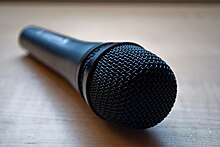Acoustic pressure
What is acoustic pressure?[edit | edit source]
The Acoustic Pressure is the force of sound on a surface area perpendicular to the direction of the sound. The Acoustic Pressure can also sometimes be called The Sound Pressure.
The standardised unit for acoustic pressure is Pascals (Pa), this can be worked out easily by the following:
- Unit for force is N (Newton)
- Unit for surface area is m2 (metre squared)
- Acoustic Pressure is equal to Force divided by Surface Area.
- Acoustic Pressure = Force/Surface Area; unit is N/m2
Therefore unit of acoustic pressure is equal to N/m2 which is also equal to Pascals.
How is acoustic pressure measured?[edit | edit source]
Acoustic Pressure can be measured by two ways:
- Microphone
- Hydrophone- can be used under water


Acoustic pressure level[edit | edit source]
Acoustic pressure level is measured on a logarithmic scale and decibels is a standard for Acoustic Pressure level.
The lowest acoustic pressure that a human is capable of hearing is 20 micropascals. This is very small and this is why we convert pascals into decibels for everyday usage. 20 micropascals is used as a standard for acoustic pressure and is equal to 0 decibels.
20 micropascals= 0 db
The maximum acoustic pressure of human hearing has not been fully established but there has been an estimate to the maximum acoustic pressure which is around 120 decibels or 130 and is known as the pain threshold. But what is considered painful for one person may be considered entertainment for others. Usually younger generations are able to withstand louder sounds than older generations.
Acoustic impedance[edit | edit source]
When the amplitude of the wave is minimal, acoustic pressure and the velocity of the particle has a proportional relationship. The proportion of acoustic pressure and velocity is known as the acoustic impedance.
The factors of acoustic impedance are the following:
properties of the wave
the object that the wave is progressing through
Z = P/U,
where Z is acoustic impedance, P is sound pressure, U is velocity of the particle
Distance law[edit | edit source]
When observing an experiment on acoustic pressure, it is vital for the measurement of the object from the source, the acoustic pressure has a inverse proportional relationship with distance from the source.
Acoustic pressure level[edit | edit source]
Acoustic Pressure level is measured on a logarithmic scale and decibels is used as the reference. The threshold of human hearing is 1 decibel. Nearly all measurements of sound levels are compared to one decibel. When measuring the sound source, the distance of the sound source from the microphone is not included when the acoustic pressure level is calculated. One metre from the source is usually the distance used
Examples of acoustic pressure[edit | edit source]
I have found some examples of sound pressure which are the following:
Normal Breathing = 10 dB
Washing Machine = 50 dB
http://en.wikipedia.org/wiki/File:LGwashingmachine.jpg
Grenades = 180 dB
http://www.google.com/imgres?um=1&hl=pt-PT&sa=N&tbo=d&biw=1280&bih=675&tbm=isch&tbnid=6Y9aAWFeYXuyqM:&imgrefurl=http://www.politicsforum.org/images/flame_warriors/flame_64.php&docid=f9GBNogg8hqF3M&imgurl=http://www.politicsforum.org/images/flame_warriors/grenade.jpg&w=576&h=472&ei=4WfGUL71NYTWsgax1YHQDQ&zoom=1&iact=hc&vpx=253&vpy=176&dur=1809&hovh=203&hovw=248&tx=138&ty=82&sig=116473563740357941605&page=1&tbnh=136&tbnw=177&start=0&ndsp=23&ved=1t:429,r:2,s:0,i:92
